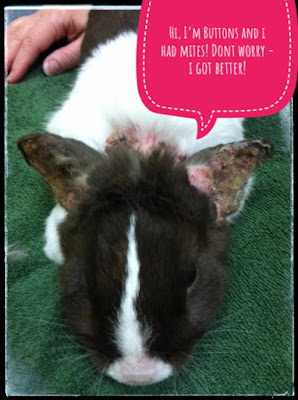You see, I know some of you got yourself a cute little baby bunny at Easter and now that little cutie is starting to act more like a Tasmanian Devil. In fact, this is the time of year that rabbit rescues dread - when the cute little babies become hormonal nut jobs and their people decide to dump them. Please don't dump your bunny - I have the solution: speutering!
Let's talk about this, shall we? Here are a few reasons that spaying or neutering is a good thing to do:
1. Not fond of your Tasmanian Devil? Most of the behaviors that are driving you crazy (lunging, spraying, not using the litter box, mounting your feet, biting, etc, etc, etc) are the result of bunny hormones. What's the answer? Get rid of the hormones! It can take a few weeks, but after speutering the hormones will dissipate and your little fluff ball will be much better behaved.
2. The C-word. Sadly, unspeutered bunnies are very prone to reproductive cancers. Not spaying or neutering is almost like inviting cancer into your bunny's life. Seriously.
3. We're less stinky! That litter box smell? So much better after speutering!
4. No, we won't get fat and lazy! Plus we'll be a whole lot calmer, and can focus on playing with you instead of looking for a mate.
5. Bunnies are very social, and speutering makes it easier for you to have two (or more!) Unspeutered rabbits tend to want to guard their territory and will fight - even if they are siblings. If your bunnies are male and female, they'll reproduce. You may not see this as a problem, but please think about this: rabbits are the third most often euthanized animals at shelters across the country! By letting your bunnies have bunnies, you are contributing to this serious problem.
Please don't think you can just get one of your pair done. Nope. It doesn't work that way. The intact bunny will still act out their hormonal behaviors, and fighting is still a strong possibility. Plus if you get your male neutered and leave your female unspayed, he is still able to father baby bunnies for several months after surgery. You could still wind up with a litter of bouncing baby bunnies!
6. You may think getting your rabbit speutered isn't "natural". Well, no, it isn't - but neither is keeping a rabbit as a pet either. Remember that we've only been domesticated a few hundred years, and we have many of our wild behaviors still. Getting us spayed/neutered is definitely a good way of helping us adjust to this "unnatural" situation.
7. If you do let your rabbits reproduce, things tend to get out of control fast. This is where I need to tell you my story!
This is me and my siblings when we were just three days old:
 |
Our original person got our parents from someone who raised rabbits for meat, and occasionally sold them as pets. He swore to my parents' person that even though my parents were only 6 weeks old he could tell their sex, and they were both girls. Absolutely, positively two girls.
A couple of months later, one of the two "girls" gave birth to three adorable babies!
Lesson #1: It's very hard to sex young rabbits. Very, very hard!
Lesson #2: Rabbits can get pregnant as early as three months old!
Our person was wonderful, but didn't know much about bunnies and didn't realize she needed to separate my parents immediately. She didn't figure that out until a couple of days later, but by then it was too late. About a month after the first litter, my mom had eleven more babies!
Lesson #3: Rabbits can get pregnant the day they give birth, and their gestation period is only about 30 days. And bunny litters can be large - lots and lots of babies!
My secretary has seen situations where two bunnies turned into 60 or 70 in less than four months. It's crazy, right?! In my case, my parents were lucky, because our person knew she was in over her head. She got help from my secretary's rescue and we all got speutered before any more babies happened!
The costs of taking care of 14 babies and two parents were over $4000 - money that the rescue had to raise because our person couldn't afford it. Plus, since we were New Zealands, very few people wanted to adopt us, and five years later three of us are still here in sanctuary. My secretary says we were worth it, but still - if you have the chance to get your bunny taken care of, why bring extra bunnies into the world? Especially when there are some real benefits to spay and neuter!
I feel like I'm the poster child for why you should get your bunny speutered! Have I convinced you? I hope so! I know bunny people have lots of concerns about their rabbit having surgery, so that's why my next posts are going to be on how to find a great rabbit-savvy vet, and aftercare for spay/neuter surgery.
Want more information on spay and neuter? Here's some great links:
*The wonderful Dana Krempels wrote this piece on spay and neuter.
*The Rabbit Welfare Association has a good article here.
*We love Best Friends Animal Sanctuary! Here's their article.
Until next time!
Señor Spaghetti,
Huntsville Friends of Rabbits Minister of Health








